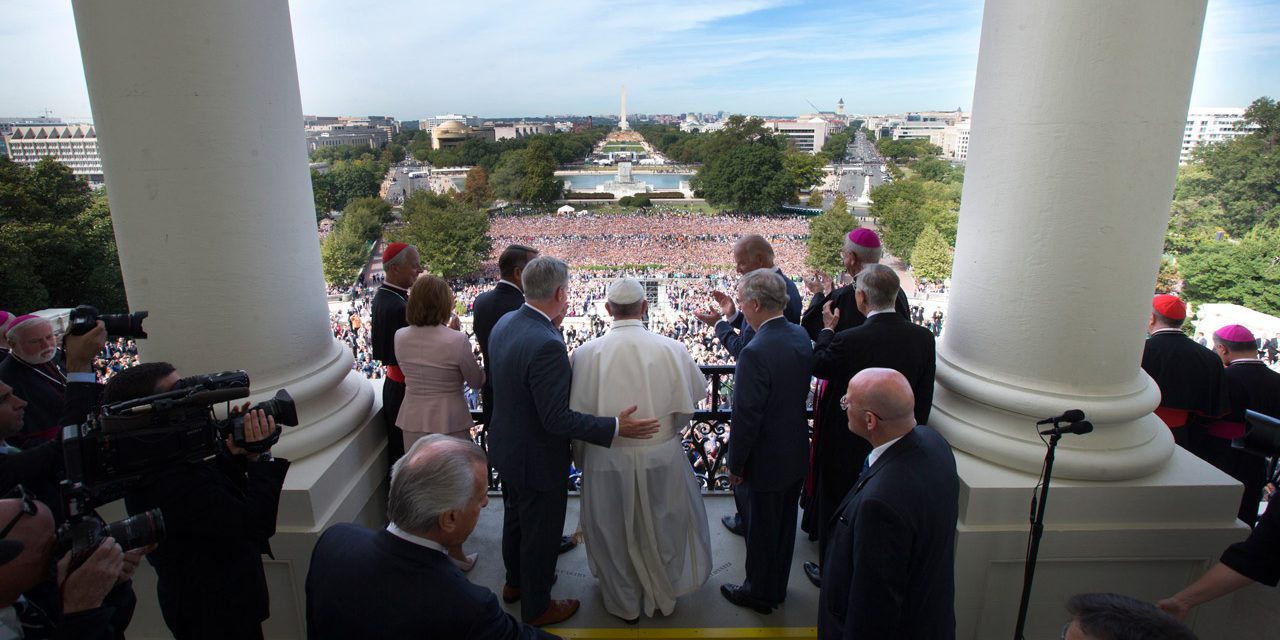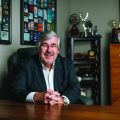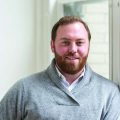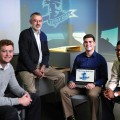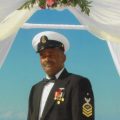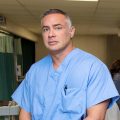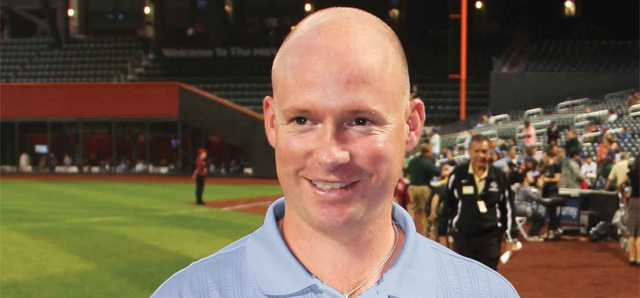Pope Francis made his first visit to the United States from September 22 through September 27, 2015, stopping in Washington, D.C., New York City and Philadelphia. Seton Hall was present in the week’s activities — both directly, in the ways our community members participated in the visit, and indirectly, through a symbolic gift the president shared with the pontiff upon his arrival at the White House. President Barack Obama gave the pope a 116-year-old key from the home of Saint Elizabeth Ann Seton, our University’s namesake, to celebrate her — and the pope’s — dedication to the sick and the poor. The story that follows details the experiences of just a few Seton Hall community members as they celebrated this historic occasion.
Washington: Tuesday, September 22
The plane had just landed. Everybody was waiting for Pope Francis to emerge: President Barack Obama and Vice President Joe Biden, bishops and clergy, an honor guard and a delegation of Catholic schoolchildren, all on the tarmac at Joint Base Andrews outside Washington, D.C.
Andrea Bartoli, the dean of the School of Diplomacy and International Relations, was watching, too, on a monitor in a broadcast studio in New York. His job for the day was to help explain to his ABC News radio audience how Pope Francis differs from other popes, and how this visit would likely differ from previous papal visits.
“When you make the comparison of Pius XII, for example, and Francis, it’s just extraordinary,” Bartoli told listeners. “Pius XII, you could not see him walk. He was never walking in front of anybody. You were imagining the pope as if he was a demigod. He was on a different planet.”
Back in Washington, the plane door opened and Pope Francis, his head bare, walked down the stairs — in front of everybody, and very much on this planet — carrying his zucchetto in his hand to keep it from blowing away, taking his first steps onto American soil. After all the greetings, he got into a small black Fiat 500L hatchback that was dwarfed by the phalanx of SUVs escorting it.
“You can see that there is a joyfulness to the moment that is very, very important, and yet there is also a simplicity to the protocol,” Bartoli told his audience. “It’s a very good beginning.”
It was the beginning of a busy six days, not just for the pope but for a number of members of the Seton Hall community who intersected with him along the way — offering news commentary; covering his trip on social media; attending his Masses in Washington, New York and Philadelphia; and even flying Shepherd One, the American Airlines 777 that ferried him around the United States and then back to Rome.
Washington: Wednesday, September 23
Two buses left the Seton Hall campus before dawn, bound for Washington with 80 seminarians and four priests from Immaculate Conception Seminary and the College Seminary at St. Andrew’s Hall.
“We were so many that I was not able to find a seat, so they put us outside the basilica,” said Dailon Lisabet-Sanchez, 29, a first-year student at Immaculate Conception Seminary who stood with fellow classmates on the front steps, watching the Mass on the large video screens.
He saw Francis from a distance twice, as the “popemobile” arrived and left. His mother had gotten a better view two days earlier in Cuba at the Mass the pope said in Holguín, the diocese where Lisabet-Sanchez lived until he left to join his father in Miami in 2006. “She was very happy to see him,” he said. “It was the first time she saw a pope.”
He had seen the pope once before, on a spring break trip to Rome with some St. Andrew’s classmates, but the canonization Mass of Junípero Serra touched a deeper spot in him. “To know that he was a man who was one of the first who came here to the United States and brought the faith, that’s something that’s special.” (The seminary has a gold silk chasuble from the Franciscan missionary seminary in Mexico that was home for 18 years to Serra, who is thought to have worn it.)
While Lisabet-Sanchez and his fellow seminarians watched the Mass from the basilica steps, Father Michael Russo ’67/M.Div. ’75 watched from a place familiar to him from all the other papal visits he has covered since 1978: a television control-room truck parked outside. “I always tell people, ‘You probably see more of the papal trip than I do,’ in the sense that I’m not following every moment of the pope’s day,” said Father Russo, a professor of communication studies at St. Mary’s College of California.
Father Russo’s pope-watching career started in 1965, when Pope Paul VI became the first pope to visit the United States. He and his father saw the pope bless St. Patrick’s Cathedral and bless the crowd. “I’m a real groupie when it comes to that kind of thing.”
Father Russo’s journalism career started when he was in the seminary and was hired by a fellow alumnus to work as Walter Cronkite’s desk assistant at CBS News. He continued working in the special events unit at CBS — “elections, conventions and moonshots,” as he describes it, and eventually papal deaths, elections and visits. For this visit, he was working as a media expert for the United States Conference of Catholic Bishops, consulted and interviewed by reporters and producers following the pope. He also wrote for the ABC News political blog, The Note, and for his own blog, The Francis Factor.
None of this got him any closer to a photo-op with the pope than a life-size cutout at one of the media centers where he spent the week.
“People have this funny notion that somehow if you’re a priest you’re just going to be escorted into a room with the pope,” he said. “There are many more bodies ahead of me.”
Washington: Thursday, September 24
Father Russo watched the pope’s speech to Congress from the press room “several stories into the belly of the Washington Convention Center,” as he wrote in his blog. He was moved when Pope Francis cited two prominent American Catholics in the speech — Dorothy Day and Thomas Merton — but he highlighted another, perhaps more telling, moment in his ABC News blog.
“For me, one amazing image of Pope Francis stands out, that of him riding in the ‘popemobile’ as his motorcade moved down Pennsylvania Avenue from the White House to St. Matthew’s Cathedral,” he wrote. “The cheering crowds on the sidewalk, the fast pace of the Secret Service beside the vehicle, and the pope’s loving and smiling embrace of the few children allowed to come to him caught my attention. We have parades like this for presidential inaugurations, but this was one huge victory lap, and reminiscent in size to that of General Douglas MacArthur’s return from the Pacific after World War II.”
Late that afternoon, Father Russo took the train to New York, and Pope Francis took his Fiat back to Joint Base Andrews. An American Airlines 777 — with a papal insignia decal outside and a microphone system inside so he could talk to the traveling press — was designated as Shepherd One and assigned to carry him to New York and Philadelphia and then back to Rome.
“It wasn’t really until we were at Andrews and the motorcade circled and he was on his way up the jet bridge that I was like, ‘Holy moly, I’m flying the pope,” said Thomas Murray, whose daughter Laurel is a junior communication major at Seton Hall.
Murray, a pilot with American for more than 30 years, had gotten the call two months earlier asking him to serve as first officer on the four-person flight crew. He and his wife, Donna, are devout Catholics, active both in their parish (St. Paul’s in Princeton, N.J.) and in the schools their three children attended. “I thought of nothing else every waking moment for two months,” he said. “If I had a free second, I was thinking about it.”
He prepared by compiling a 140-page guide for his iPad. He flew C-141 transport planes in the Air Force Reserve for 10 years, is a decorated veteran of the first Gulf War, has hauled the limousine on presidential trips and has twice carried secretaries-general of the United Nations. “But they’re not in the same category as His Holiness.”
New York: Friday, September 25
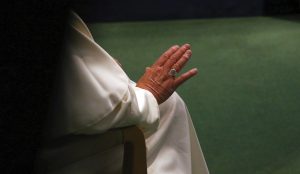
While Pope Francis was addressing the United Nations General Assembly on Friday, Dean Bartoli was at the National September 11 Memorial and Museum in New York, waiting to see him at the interfaith prayer service; Father Russo was sitting with a TV anchor from the local CBS affiliate in a makeshift studio atop an adjacent hotel, offering more commentary; and Marianna Eboli, a junior diplomacy major, was shuffling slowly in the daylong line to enter Central Park for the papal motorcade late that afternoon, posting all the while on Twitter, Snapchat and Instagram for a social-media campaign called Pope Is Hope.
As Bartoli waited for the Ground Zero service to begin, he spoke live on The Brian Lehrer Show on public radio station WNYC. “The scene is incredible, and we are actually in the cavernous area of the memorial where you are really deep into the earth, and everybody’s here, all religions, all people of the earth,” he told the listeners. “And with this pope that is many ways not just somebody to talk but somebody that really would like to listen, somebody that would like to welcome the sorrow of humanity, somebody that would like to connect with the pain of humanity, I think that this is a perfect place and a perfect moment.”
As the pope left to visit a school in East Harlem, Mari Eboli was still trudging along in the Central Park line, wearing a T-shirt emblazoned with the pope emoji that the Pope Is Hope campaign was spreading.
Eboli had been chosen as one of the volunteers for the “digital street team” sponsored by Aleteia USA, a Catholic global media company, and a CBS camera crew was following her for a story. “The whole point was to show the pope’s visit through the millennials’ eyes in social media,” she said. “We wanted to show that, in the moment of need that the world is at, we’re all still together, we’re all still doing acts of kindness; that no matter how hard things get, good is winning and good will win.”
After almost eight hours in line, Eboli finally reached a spot atop a small rise near the end of the pope’s motorcade route through the park. “You could hear this wave of screams and cheering coming,” she said.
She tweeted a message and a photo of him waving: “And just like that he stole my heart, the cutest little thing I’ve ever seen! Feeling so blessed,” she wrote.
Then she watched him get into the Fiat for the trip to his next stop, Madison Square Garden. “When I saw him I had tears in my eyes. I called my grandma in Brazil so she could feel the emotion that everyone was feeling.”
The Mass at the Garden was the pope’s last New York event, and in the crowd were 16 seminarians from the Diocese of Camden who are studying at Immaculate Conception Seminary. “What struck me was the effort he was making,” said John March, a graduate of the U.S. Naval Academy who served as a Marine officer in Iraq and is now a first-year seminary student. “I was struck by his work ethic, that at his age he’d be willing to take on a schedule like he did.”
March kept a particularly close eye on Pope Francis after Communion. “You could just tell he’s a very prayerful man,” he said. “He seems to really focus on the condition of our hearts, and that we do have numbness in our hearts. He’s encouraging us to let God soften those numb parts of our hearts, and that’s a message I need to hear.”
Philadelphia: Saturday, September 26
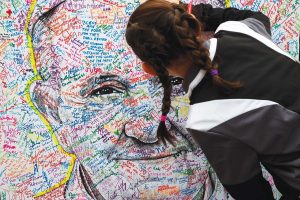
On Shepherd One’s flight from New York to Philadelphia on Saturday morning, Thomas Murray’s passenger had a surprise request. “He asked to sit in the cockpit with us,” he said. So the pope sat in a jump seat behind the pilots, right next to the laptop sleeve in which Murray was carrying flags from his children’s schools, including Seton Hall. “It was just so amazing to be sitting in my workplace with His Holiness sitting right behind me.”
That night, when Pope Francis presided over the Festival of Families, Andrea Bartoli was among the guests seated onstage with him. “He spoke off the cuff, and he was clearly at home, and clearly very happy with people,” Bartoli said. “He has this wonderful warmth that is so inviting, and America responded to that very beautifully — the idea that we could be better, that we can take care of one another.”
And at the end of the evening — after Andrea Bocelli had sung the Lord’s Prayer, and Pope Francis had led the massive crowd in a Hail Mary and offered a final blessing — Andrea Bartoli shook the pope’s hand.
Philadelphia to Rome: Sunday, September 27
The flight home on Sunday night was the leg of the trip that concerned Thomas Murray the most. They were headed not to the main airport in Rome, but to a smaller, secondary one with a shorter runway.
The pope offered personal audiences to each of the crew members on the flight, and it was somewhere over the Atlantic that Murray had his. “You sit down and try not to cry right off the bat,” he said. “The Vatican took photos and in the first one it looks like I’m about ready to break down. He’s got a big smile on his face and all he’s looking at is me.”
Murray then gave the pope a patch he had designed as a memento of the trip: the pilots’ names around the Vatican logo for the U.S. visit, with the pope’s own motto at the bottom: Miserando atque eligendo, humble and chosen. “I explained to him that we were very humbly chosen as pilots,” he said.
The landing was smooth and uneventful. “When we got to the parking spot and I shut down the engines, the whole trip washed over me. We’d been up most of the night so it was mixture of relief and exhaustion,” he said. “And then I turned around and His Holiness is standing there. He had come to the door to say thanks.”
Kevin Coyne is a freelance writer based in New Jersey.

